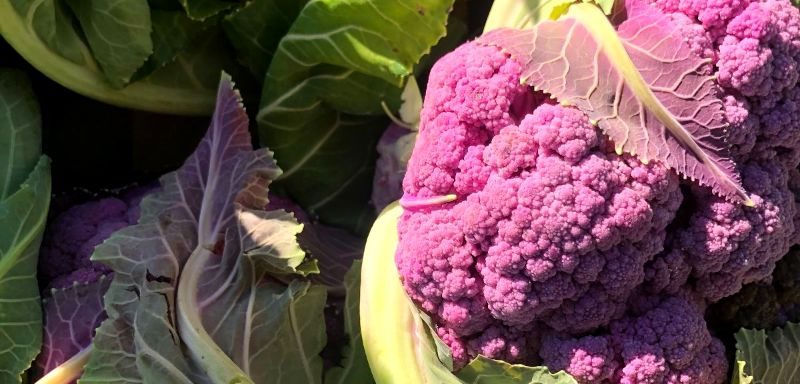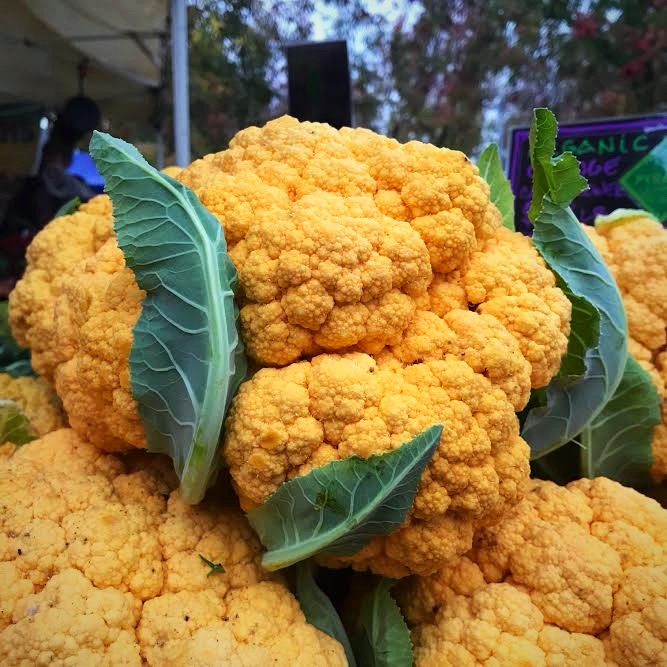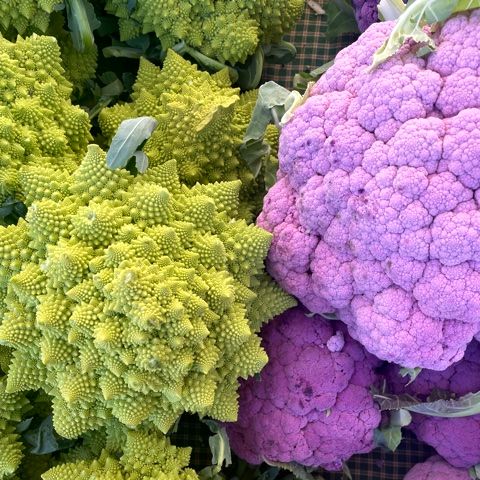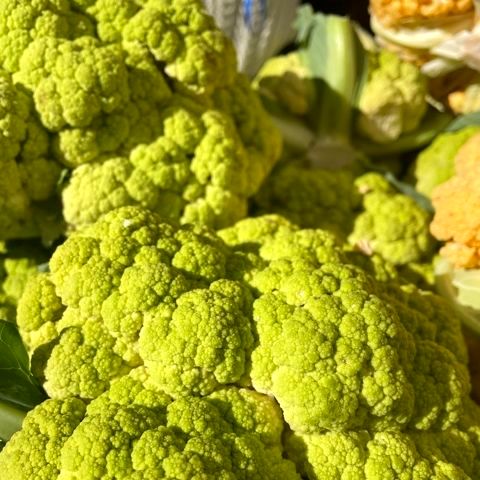The Perks of Being a Cauliflower (and Romanesco!)
Who says winter produce is boring?! Despite what some might think about veggies in winter, you’ll definitely see some vibrant colors at the Chico Certified Farmers’ Market all year round! Cauliflower, a member of the brassica family, comes in more colors than you might think and are some of the most beautiful, colorful and unusual products of the season!
Being fun and gorgeous aside, cauliflower is all the rage right now because of its popularity as a vegetable alternative for grains and starches. Besides being a healthy way to add more vegetables to your diet, it is extremely versatile in recipes. The flavor is very neutral and while it becomes tender, it still holds its shape when cooked (not to mention a shorter cooking time compared to boiling and simmering grain rice). It’s a great low carb substitute – think pizza crust or a substitute for mashed potatoes, tater tots, rice dishes – you name it!
Do you ever wonder how traditionally white cauliflower becomes orange, purple, or green? Or just what romanesco is exactly? We did! Below is some insight to the differences between each, as well as an easy peasy tutorial with a few ways to rice your own cauliflower at home – go forth and experiment with the endless cauliflower options!
- 26cd6b40 00f5 033f d81a 7cde5c70aad9
- acfc135e ca18 1083 01e6 ba22092338eb
- 0b8d9426 ed63 5b21 34ce 1ef3736f5df8
Purple, Orange, and Green Cauliflower!
Purple Cauliflower
While one may think this is a dyed produce, it’s not! Purple cauliflower gets its hue from the antioxidant anthocyanin (a naturally occurring phytochemical), also found in other purple or blue fruits, as well as red wine. Purple cauliflower tends to be sweeter, nuttier and less bitter than white cauliflower. Grilled, roasted, or sautéed, it retains its lavender beauty, especially with a little lemon or vinegar splashed on before cooking (though some purple varieties can turn green if overcooked).
Orange Cauliflower
Orange cauliflower was first discovered in Canada in 1970, although it took years of crossbreeding for the variety to become widely available. The color comes from a genetic mutation that allows the plant to hold more beta carotene. It also contains about 25% more vitamin A than white cauliflower. Its color can range from creamy coral to sunburst orange and it is sometimes referred to as “cheddar” cauliflower.
Green Cauliflower
Green cauliflower, also known as broccoflower, is a hybrid of broccoli and cauliflower. Green cauliflower contains more beta carotene than white cauliflower, but less than broccoli.
Bonus: Romanesco
While Romanesco is most likely the least familiar of the bunch, it’s definitely the most interesting! We like to give Romanesco some extra love during cauliflower season also! Romanesco is an edible bud that is also commonly referred to as Romanesco Cauliflower or Romanesco Broccoli (technically it would be in the green cauliflower category). What makes it so interesting is it’s unmistakable texture and intricate, mathematical pattern (it’s a fractal!). With a flavor similar to broccoli (but perhaps a little earthier) it’s super crunchy and textural. Romanesco is great for anything from crudites to simply steaming, roasting, or sautéing. The trick to keeping its vibrant color is to blanch the florets and then shock them in an ice bath. After that you can add it to just about anything!
Don’t Want to Lose that Color?
Orange cauliflower had proved to be the most stable of the three when it comes to retaining color – the orange pigments are not water soluble or sensitive to heat. The chlorophyll in the green cauliflower is heat sensitive just like broccoli; overcooking will result in the cauliflower to becoming brown. The anthocyanins in purple cauliflower leach out in water which dulls it’s color – for purple the color is better retained with dry heat such as roasting, grilling, or sautéing.
- 9020a20e 6399 3a8d bff8 1807e441af69
- 9db2c31a 84b0 ac03 9fff 6381f4ac7bd6
- b5a700b0 d032 ea27 1d01 b7f15db79d85
How to Make Cauliflower Rice – 4 Ways!
Not everyone has the same tools, so here are a couple simple techniques to help you effortlessly add or sub this veggie to your meals no matter what you’re working with!
Prep Your Cauliflower
1. Use a knife to remove the outer leaves and cut off the cauliflower florets from the stem. Cut florets into 1-inch sized pieces.
2. Use preferred method below.
Chop
Using a large chef’s knife, remove the florets from the steam. Mince into tiny pieces, resembling the size and shape of rice grains. This process is a little longer than the other methods but is the simplest to do with minimal tools.
Grate
Use a box grater or a microplane grater with medium-sized holes to push across the florets and make smaller pieces. Keeping the florets larger makes it easier for grating.
Food Processor
Cut the cauliflower into smaller 1 to 2-inch florets. Add about 4 cups of florets or 3/4 of the way full in a food processor. The amount will vary depending on the size of the food processor, work in batches if needed. Pulse the cauliflower until small pieces are formed. You may need to stop periodically and scrape the sides of the bowl. If larger florets go unprocessed, take them out, transfer the cauliflower rice to a bowl, and then add back the larger pieces and process again.
Blender
Cut the cauliflower into smaller 1 to 2-inch florets. Add about 4 cups of florets in a high-speed blender. Blend the cauliflower until small pieces are formed, using the tamper handle on top to push down the florets, about 15 to 60 seconds. You may need to scrape the sides of the blender cup similar to the food processor instructions. Pulsing the blender with make more uniform pieces.
Don’t know what to do with your new cauliflower rice? Sauté it, steam it, or stir fry it! Try rice bowls, fried rice, grits, couscous, or risotto! Best part: freeze whatever you don’t use in your recipe for another time!






